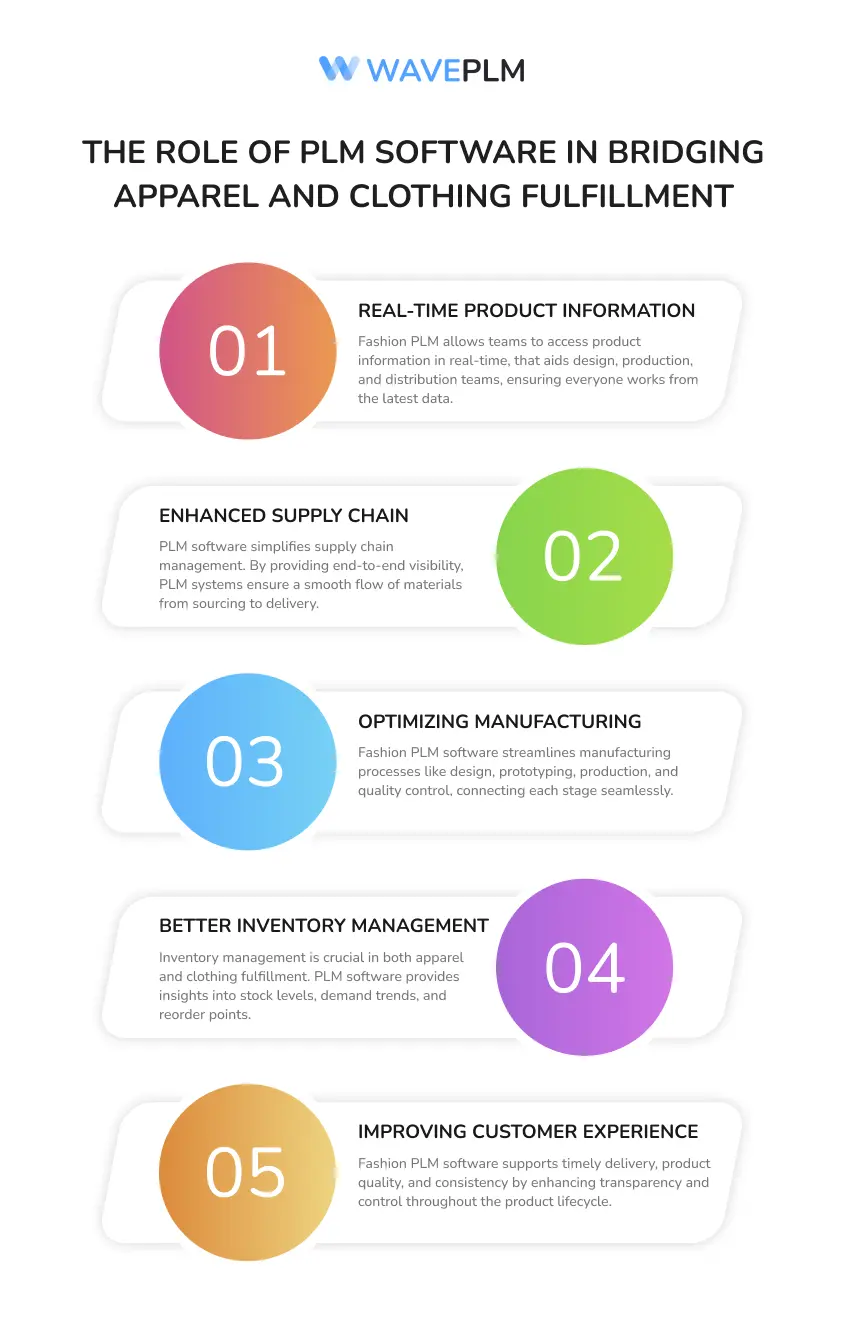
In the fashion industry, understanding the difference between apparel fulfillment and clothing fulfillment is key. While these terms seem similar, they serve distinct roles. Apparel fulfillment typically involves a larger scope, covering various product types and processes. Clothing fulfillment focuses specifically on garments, from design to delivery. Both require effective management of the supply chain, inventory, and customer experience. This article explores how such apparel management software as Product Lifecycle Management (PLM) software helps bridge the gap between apparel and clothing fulfillment, improving efficiency, reducing costs, and enhancing customer satisfaction.
What Is Apparel Fulfillment?
Apparel fulfillment manages the complete process of handling fashion products. It includes inventory management, packing, shipping, and delivering a wide range of products. The scope goes beyond just clothing; it includes accessories, shoes, and other apparel-related items. The aim is to ensure a smooth and efficient process from manufacturer to end customer.
For brands, managing these processes can be complex, especially when dealing with high product variation. Apparel fulfillment services help brands streamline their operations, ensuring timely deliveries and reducing inventory issues. With PLM software, brands can efficiently manage design, sourcing, and production, resulting in faster time-to-market and better customer satisfaction.
What Is Clothing Fulfillment?
Clothing fulfillment is more focused on handling garments specifically. It involves similar processes—inventory, packing, and shipping — but usually only applies to clothing items. This specialization often benefits brands that focus solely on fashion apparel, where specific garment details and standards matter.
For example, managing a line of casual wear differs significantly from managing a full range of apparel, including shoes or accessories. Clothing fulfillment, therefore, zeroes in on maintaining quality and consistency within these focused lines. PLM systems assists by providing real-time updates, optimizing design and production, and ensuring quality standards across every piece.
The Role of PLM Software in Bridging Apparel and Clothing Fulfillment
Product Lifecycle Management PLM software plays a critical role in both apparel and clothing fulfillment. By integrating fashion PLM systems into these processes, fashion brands can manage their products more effectively. Let’s explore how apparel software like PLM enhances both apparel and clothing fulfillment:
1. Real-Time Product Information
Fashion PLM allows teams to access product information in real-time. This immediate access aids design, production, and distribution teams, ensuring everyone works from the latest data. This capability reduces errors and miscommunication, leading to more efficient fulfillment.
With real-time updates, brands can monitor design changes, production schedules, and inventory levels. It allows them to make quick adjustments, reducing the chances of stockouts or overproduction. The result? Improved customer satisfaction and reduced environmental impact.
2. Enhanced Supply Chain Management
PLM software simplifies supply chain management. By providing end-to-end visibility, PLM systems ensure a smooth flow of materials from sourcing to delivery. This visibility helps brands understand bottlenecks and address issues proactively, keeping timelines intact.
With better control over the supply chain, brands can make informed decisions on sourcing materials, selecting suppliers, and managing shipments. This advantage is particularly beneficial in the fast-paced fashion industry, where delays can lead to lost sales and dissatisfied customers.
3. Optimizing Manufacturing Processes
Manufacturing processes in fashion involve multiple stages: design, prototyping, production, and quality control. Fashion PLM software streamlines these processes, connecting each stage seamlessly. Teams can monitor each phase, ensure quality standards, and address issues before they affect the final product.
For instance, a design team can collaborate with production teams to address potential issues early. By using apparel PLM software, brands can reduce waste, improve product quality, and meet customer expectations. This optimization also lowers production costs, making it a win-win for brands and consumers.
4. Better Inventory Management
Inventory management is crucial in both apparel and clothing fulfillment. PLM software provides insights into stock levels, demand trends, and reorder points. These insights help brands avoid overstocking or stockouts, which are costly and harm customer experience.
With accurate inventory data, brands can manage their stock based on real demand rather than assumptions. This approach not only reduces costs but also minimizes waste, contributing to a more sustainable supply chain.
5. Improving Customer Experience and Satisfaction
Customer satisfaction relies on timely delivery, product quality, and consistency. Fashion PLM software supports these goals by enhancing transparency and control throughout the product lifecycle. By managing design, production, and fulfillment under one system, brands can ensure a smoother, more reliable customer experience.
For example, if a design update improves product durability, that change reaches production quickly through PLM software. Customers receive high-quality products, building brand loyalty and trust.

Reducing Environmental Impact with PLM Software
The fashion industry is increasingly focused on reducing its environmental impact. Fashion PLM software helps brands meet this goal by supporting sustainable practices. Through better inventory and manufacturing management, brands can lower their carbon footprint and minimize waste.
For instance, by reducing overproduction and managing raw materials efficiently, PLM systems helps brands adopt more eco-friendly processes. Additionally, transparent supply chain practices give customers insight into the brand’s sustainability efforts, boosting consumer trust.
Bridging the Apparel and Clothing Fulfillment Gap with Project Management
Project management is essential for apparel and clothing fulfillment, especially for brands handling complex operations. PLM software comes with built-in project management tools, allowing teams to plan, execute, and track their projects effectively. This feature ensures that each department aligns with overall business goals and works cohesively.
Project Planning and Coordination
PLM systems support detailed project planning, helping teams organize tasks, set deadlines, and assign resources. By maintaining a centralized plan, brands avoid overlapping tasks and manage timelines better. This feature is crucial in apparel fulfillment, where delays in one stage can cascade through the entire supply chain.
Task Tracking and Accountability
With PLM’s project management tools, teams can track task progress, assign responsibilities, and monitor completion. This level of accountability helps identify issues early, preventing costly delays. Brands can use these insights to improve efficiency and deliver products on time.
Managing Products from Design to Delivery with PLM Systems
PLM systems offer a single platform for managing the complete product lifecycle. From initial design to final delivery, brands can monitor every stage. This holistic approach simplifies fulfillment, reduces errors, and improves customer satisfaction. Here’s how PLM software streamlines the process:
Centralized Product Data
Fashion PLM store all product data in one place, ensuring consistency and accuracy. Designers, manufacturers, and marketers can access the same information, which reduces miscommunication and errors. This data includes design specifications, material requirements, and production schedules, helping teams make informed decisions.
Continuous Improvement in Product Quality
Through data analysis, PLM identifies areas for improvement in product quality. For example, if certain materials lead to higher defect rates, teams can explore alternatives. Continuous quality improvement not only reduces returns but also enhances customer satisfaction.
Final Thoughts: Why PLM Software Is Essential for Modern Fulfillment
The fashion industry’s fast pace demands efficient, accurate, and adaptable fulfillment processes. PLM software bridges the gap between apparel and clothing fulfillment, offering tools for better supply chain management, inventory control, and customer satisfaction. By managing products from design to delivery, PLM systems helps brands stay competitive while meeting consumer expectations.
In summary, the key benefits of fashion PLM software in apparel and clothing fulfillment include:
- Real-time product information for efficient decision-making
- Enhanced supply chain visibility and control
- Streamlined manufacturing and inventory management
- Improved customer experience through high-quality products
- Reduced environmental impact and waste
Brands that adopt PLM software not only improve their fulfillment processes but also build a more sustainable, customer-focused business model. Whether managing a diverse range of apparel or focusing solely on clothing, fashion PLM systems supports every step of the way, making it an indispensable tool for modern fashion logistics.





Leave a Reply